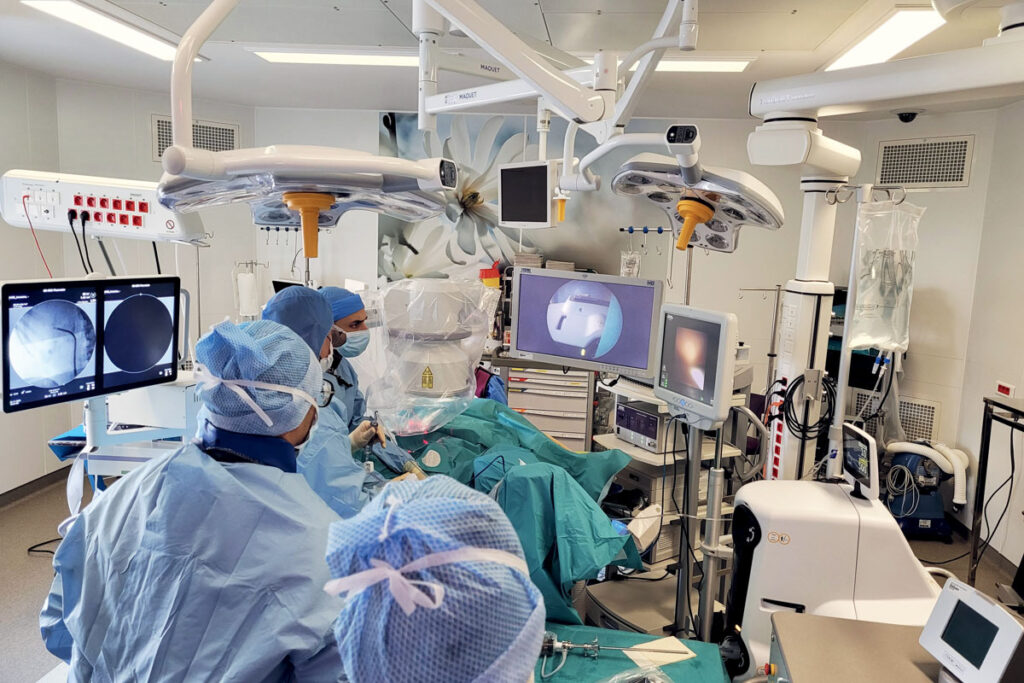[LUM#17] Innovating from head to toe
On the Saint-Priest campus, roboticists, computer scientists and electronics engineers put their know-how to work in the field of surgery. Whether they are working on intelligent prostheses like the RFEF team at the Institut d'électronique et des systèmes (IES)* or on surgical robots like the Dexter team at the Laboratoire d'informatique, de robotique et de microélectronique de Montpellier (Lirmm)**, their motivation is the same: to give innovation a strong social impact.

Every year in France, 100,000 people undergo knee replacement surgery. To improve patient follow-up, orthopedic surgeon Stéphane Naudi, founder of the start-up Bonetag, has designed an intelligent prosthesis equipped with an adhesion sensor to anticipate loosening of the bone, and traceable to ensure continuity of care.
Techno to the bone
"Stéphane Naudi came to us back in 2013 because he had heard about our sensor and RFID tag skills," recall Brice Sorli and Arnaud Vena, researchers atIES and Bonetag's scientific collaborators. The RFID tag is a radio identification technology used to trace clothing, packaging and even our dogs and cats. It's a device that contains a microprocessor, a memory and an antenna, but doesn't require a battery," explains Arnaud Vena. For Bonetag, we needed a technology that would work throughout the life of the prosthesis, without having to re-open the patient to change a battery." The inactive tag in the knee emits a radio-frequency signal when activated by a reader during the consultation.
The challenge of this innovation lay in the miniaturization of the implant. Existing electronic prosthesis projects haven't caught on because of their complexity," explains Brice Sorli, " whereas Bonetag's implant is easy to integrate into any prosthesis thanks to a notch system for which the company has filed a patent." The electronics engineers succeeded in developing a micro-device containing the RFID tag, equipped with a miniature antenna (also patented) and a sensor measuring the adhesion between the bone and the prosthesis. They have even added a temperature sensor "to detect any tissue infection", says Arnaud Vena. With 4 patents already to its credit, the Bonetag micro implant is small... but mighty!
Compass in the eye
Robotic surgeons are tough too. They first entered the operating theatre in 1985 in California, and their precision has continued to improve ever since, as Philippe Poignet, Director of Lirmm, confirms: "We perform operations to less than 10 microns. That's ten times the precision of the surgeon's hand. In 2020, together with his colleague Yassine Haddab and Zurich-based engineer Christophe Spuhler, this roboticist founded the start-up AcuSurgical. Their credo: robotics applied to retinal surgery, "microsurgery so precise that it remains the preserve of an elite group of surgeons". Together with two surgeons from Saint Etienne, they launched the Retinoct project, combining imaging and robotics. No scalpel in the surgeon's hand, but a joystock integrated into a console and linked to a robotic arm that instantly reproduces the surgeon's movements on the patient. The first human trials are scheduled for 2023...
In the skin
Another example is the Astrid Blockprint project, which revitalizes the Dermarob robot, developed in the 2000s by LIRMM, to take skin samples during reconstructive surgery for burn victims. His updated version is back in service as part of a project with Lyon-based start-up LabSkinCreations, which manufactures artificial dermis in liquid form. Its mission," explains Philippe Poignet, " will be to perform in situ robotized bioprinting of skin, with precise control over the geometry and thickness of the print.
Solid backbone
Ergonomics is also a central improvement issue in surgical practice. Since 2015, Philippe Poignet, Nabil Zemiti(LIRMM) and Stéphane Droupy of Nîmes University Hospital have been working with STERLAB to develop an assistance robot for laser treatment of kidney stones. This long and delicate procedure involves inserting a flexible camera equipped with a laser into the patient's ureter, penetrating all the way to the kidney.
" To treat a 1 cm stone, it takes around 1 hour, during which the surgeon remains in an uncomfortable position, standing between the patient's legs ", describes Philippe Poignet. With the ILY robot, which will reproduce all his gestures remotely, he will now be able to sit in front of a console and benefit from an imaging system and an augmented environment. Thanks to highly sophisticated algorithms, ILY will be able to compensate for the natural physiological movements of both patient and surgeon, and thus provide even greater precision. To date, 80 operations have already taken place, and two sales are planned for this year.
UM podcasts are now available on your favorite platforms (Spotify, Deezer, Apple podcasts, Amazon Music...).